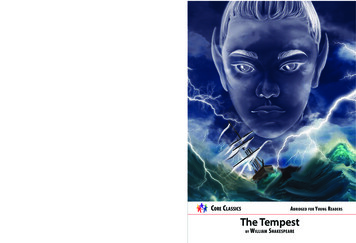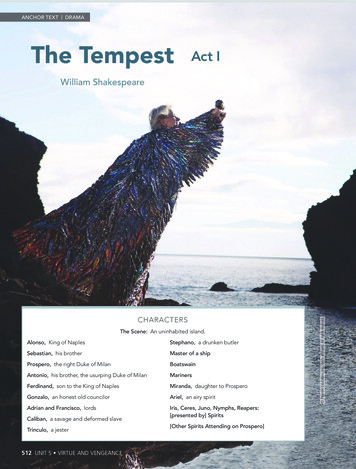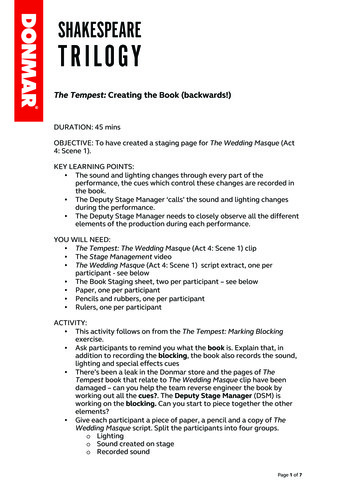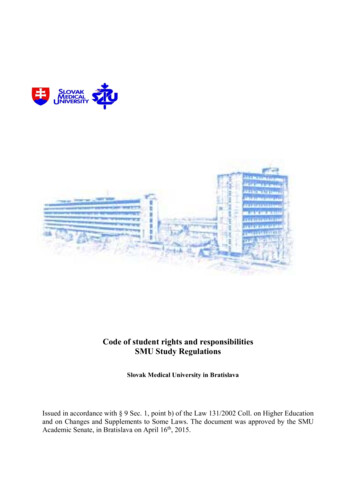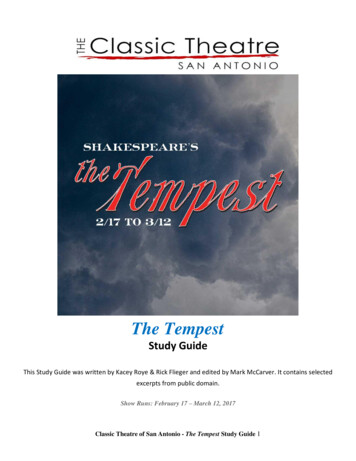
Transcription
The TempestStudy GuideThis Study Guide was written by Kacey Roye & Rick Flieger and edited by Mark McCarver. It contains selectedexcerpts from public domain.Show Runs: February 17 – March 12, 2017Classic Theatre of San Antonio - The Tempest Study Guide 1
Table of ContentsPAGESECTION3Note from the Director4The Tempest Cast & Production Crew5Synopsis7About William Shakespeare8Facts About The Tempest10Analysis of Major Themes12Vocabulary14Pre-Play Activities15Activities During the Play17Post-Play Activities18Theatre Etiquette19Free Student Programs at The Classic TheatreMISSION: The Classic Theatre creates excellent theatre that is relevant, diverse, entertaining,and transformative.VISION: We seek to achieve our mission by creating connections and conversations throughcompelling classic works.Classic Theatre StaffKelly RoushDiane Malone & Allan RossCynthia LangstonKacey RoyeFlorence BuntenOlivia ToberRita DugganExecutive DirectorCo-Artistic DirectorsDirector of DevelopmentDirector of EducationBox Office ManagerBookkeeperHouse ManagerClassic Theatre of San Antonio - The Tempest Study Guide 2
Note from the DirectorWhat happens when the rules of the script are bent, but not broken? The Classic Theatre isdedicated to creating productions that are relevant, diverse, entertaining, and transformative. Wepresent classic theatre with contemporary connections. Should you attend our production, you willfind that we have taken many liberties with Shakespeare’s script that keep with The Classic’s missionat the forefront.What happens when a character’s gender is changed? What if lines are cut? Can you stillhonor the original intention of the playwright with altered dramatic elements?We hope you will attend what we consider to be an innovative, forward thinking production,discover the surprises as they come, and decide for yourself!Mark McCarverClassic Theatre of San Antonio - The Tempest Study Guide 3
The Tempest Cast & Production CrewCast of CharactersAllan S. RossProsperoKacey RoyeArielGrace LambersonMirandaMichael HolleyCalibanHunter WulffFerdinandRick ClydeStephanoLinda FordTrinculoMagda PorterAlonsoKelly RoushSebastianMeredith AlvarezAntonioAlison Bridget ChambersGonzaloProduction StaffMark McCarverDirectorKaitlin MuseStage ManagerJohn CokerProduction Manager/Sound & Music DesignerJodi KarjalaSet/Costume DesignerPedro RamirezLighting DesignerAlfy ValdezProp Designer*Jasmin PaniaguaActing Intern*Ava ValdezStage Management Intern*AIM High internsClassic Theatre of San Antonio - The Tempest Study Guide 4
SynopsisShort Summary: Prospero, the duke of Milan and a sorcerer, is castaway on a remote island with his daughter, Miranda, through the deceptions ofProspero's envious brother Antonio and co-conspirators. Over a decade later,those responsible have been shipwrecked on the island by Prospero's magic.Begrudged creatures and drunken clowns, charmed royals and magical spiritsalike, all struggle between the temptation for revenge and greed, and thegrace of forgiveness and humility.This text of The Tempest is from Volume I of the ninevolume 1863 Cambridge edition of ShakespeareAct One: A huge storm batters a ship carrying Alonso (the King of Naples), Sebastian (Alonso's brother), Ferdinand(Alonso's son), Antonio, Gonzalo, and others. They are likely to die by shipwreck.On the island near the storm, Prospero and his daughter Miranda are introduced. We learn that Prospero has createdthe storm battling the ship. Miranda is concerned that the men aboard the ship are harmed and asks Prospero to stopthe storm. We also learn that Prospero was once the Duke of Milan but was banished to this island with Miranda byAntonio, his brother, who took over Prospero's dukedom of Milan.Ariel, a magical spirit, appears. It becomes clear that Ariel is in Prospero's service, and caused the storm at Prospero'sbidding. He tells us that the men onboard the ship have all made it ashore unharmed as planned. Caliban, amalformed beast, is also introduced. Miranda expresses her strong dislike for him, and we learn that he has beenreduced to no more than Prospero's slave.Ferdinand, who has been wandering the island, meets Miranda and falls immediately in love with her: This appears tobe of Ariel's doing and part of the carefully-laid plan that Ariel must carry out to win his freedom from Prospero.Act Two: The rest of the shipwrecked survivors wake up on the island. They are surprised that their clothes smelland feel as fresh as if they had just been bought at a market.Ariel's magic makes the party fall asleep, with theexception of Antonio and Sebastian.Antonio, who usurped his brother Prospero as Duke of Milan, convinces Sebastian to do the same thing and take thethrone from King Alonso. The two are about to kill Alonso and his men in their sleep, but Ariel awakens everyone andthe two men quickly make an excuse for drawing their swords out.Trinculo, a jester of Alonso’s court, has been wandering the island alone himself. He discovers Caliban hiding fromhim under a cloak. Fearing another storm coming, Trinculo hides under the cloak as well. Stephano, the court butler,eventually finds Trinculo under Caliban's huge frame. Caliban believes Stephano to be powerful enough tooverthrow Prospero and give Caliban his freedom. Caliban convinces Stephano and the three set off to find Prospero.Classic Theatre of San Antonio - The Tempest Study Guide 5
Act Three: Prospero, who is now invisible to Ferdinand andMiranda, witnesses the two expressing their deep love for oneanother. Prospero, realizing he is witnessing a truly rare meeting ofhearts, approves of Ferdinand for his daughter. The scene ends withFerdinand taking Miranda for his wife.Bottle in hand, Stephano, Trinculo, and Caliban continue on theirmerry way together. Stephano’s delusions of grandeur only grow,and Trinculo and Caliban dutifully follow. Caliban promises Stephanothat if Prospero is killed, Stephano will gain rule over the island andMiranda as his wife.Alonso, Sebastian, Antonio, Gonzalo, and the rest of the court arestill wandering about the island. Antonio and Sebastian decide tomake their murderous move later that night, but their conspiracy isinterrupted by the illusion of a huge banquet conjured by Prospero.As the men are about to eat, a vengeful Ariel enters, taking credit fortheir shipwreck and making the banquet vanish. A great guilt beginsto take Alonso over.Act Four: Prospero tells Ferdinand that he no longer will punishhim, but instead freely give him his daughter's hand in marriage.Prospero conjures up a beautiful, mythical, illusory party to celebrate,complete with goddesses and nymphs.Prospero instructs Ariel to lead the shipwrecked men on the island tohim. Caliban, Stephano, and Trinculo come looking for Prospero andfind a few garments on a line left by Ariel and Prospero as a trap.Caliban still wants very much to kill Prospero and carry out this plot;however, Trinculo and Stephano are very drunk, as usual, andbecome completely distracted by the beautiful clothes. Prosperosends illusions of hounds to chase them away and promises Arielthat he will soon be free.Act Five: Prospero tells Ariel that he will soon be free and that hewill miss him. Prospero also intends to destroy his ability to usemagic.After verbally reprimanding the court without their awareness,Prospero reveals himself and forgives King Alonso. Aside, he tellsSebastian and Antonio he will keep secret their plan to kill Alonso,scolding them for their actions. Stephano, Trinculo, and Calibanappear and their plot is revealed to all. And finally, Prospero revealsto the mourning Alonso that his son is alive and now happily marriedto Miranda. Prospero announces that in the morning they will all setsail for Naples. Ariel is at last set free.Epilogue: Prospero asks the audience to allow him to travel backto Naples and reclaim his life as Duke of Milan.Classic Theatre of San Antonio - The Tempest Study Guide 6
About William ShakespeareWilliam Shakespeare, often called the English national poet, is widely considered one of the greatestdramatists of all time. His works have been performed all over the world for more than 400 years.Shakespeare wrote plays that capture the entirety of human emotion and turmoil.Very little personal history is actually known about William Shakespeare. There are two primarysources that provide us with a basic outline of his life. One source is his work—the plays, poems and sonnets—and the other is official documentation such as church and court records. William Shakespeare was baptized inStratford-Upon-Avon in 1564. He most likely attended the King’s New School, focusing on reading, writing, andthe classics. At 18, he married Anne Hathaway and together they had three children; Susanna, and twins,Hamnet and Judith. In the early 1590’s, he joined a London acting troupe called The Lord Chamberlain’s Men,later changed to The King’s Men. By 1599, William Shakespeare and his business partners built the Globetheatre on the south bank of the Thames River.Shakespeare’s known work was produced between 1589 and 1613. His early plays were mostlycomedies and histories, widely regarded as some of the best of these genres. He concentrated on tragediesincluding Hamlet, Othello, King Lear, and Macbeth, until about 1608. In his last phase, he collaborated withother playwrights. At this time, he also wrote tragicomedies, or romances, such as The Tempest.As tradition may have it, William Shakespeare died on his birthday, April 23, 1616, though manyscholars believe this is a myth. Church records show he was entombed at Trinity Church on April 25, 1616.Classic Theatre of San Antonio - The Tempest Study Guide 7
Facts About The TempestBermuda’s coat of arms (right) features arepresentation of the fated shipwreck and thestorm (or tempest) that caused it, under which is aLatin phrase that translates as “Whither the fatescarry us.” The 1623 First Folio of Shakespeare’s plays classifies each play as a comedy, tragedy, or history. Inthe Folio, The Tempest is classified as a comedy. Some modern scholars, however, agree that some ofthe so-called comedies are more romantic than comical and have proposed a new category: theromances, of which The Tempest is an example. The Tempest stands out from nearly all of Shakespeare’s other plays as an original story with little preexisting literary source material. One event, however, almost certainly gave Shakespeare the idea ofwriting about the survivors of a shipwreck. In 1609, the supply ship Sea Venture sailed for the newcolony of Jamestown in what is now Virginia. After taking on water during three days of storms, the shiphad to be grounded off the coast of the “Isle of Devils” (now Bermuda). Miraculously, all 150 peopleaboard made it to shore. After nine months, most of them sailed on to Jamestown on two ships theybuilt from island trees and salvaged parts from the wreck. (See Bermuda’s Coat of Arms above). Trinculo is a classic Elizabethan clown--his original costume would have been a multicolored jester suit,making his role immediately obvious to an audience that loved “fool” characters. Trinculo’s charactertype, the “silly servant,” originates in Italian Commedia dell’arte (“comedy of craft,” or improvisation),which typically featured two zanni (foolish servants--the English word “zany” derives from zanni).Trinculo is based on the Italian character type of the second zanni: a simple-minded character wholacks moral principles, but in an innocent, non-vicious manner. Italians called this character Arlecchino,from which the English sound-alike word “Harlequin.” Stephano is also a Shakespearean fool, based onthe Italian comic character of the first zanni: a character who “hesitates at nothing He has noconscience, [and] his assistance is invaluable in executing the murder of a rival All his relationshipsare exploitative, and he loves nobody.”Classic Theatre of San Antonio - The Tempest Study Guide 8
Did You Know?The Decemberists sing about The TempestThe song titled “The Island,” on the album “The Crane Wife,” by TheDecemberists, makes several references to The Tempest. Some referencesinclude Sycorax, the storm, the island, Miranda, Prospero, and Caliban.Click on The album cover of “The Crane Wife” to hear “The Island”“O brave new world, that has such people in it!”Miranda:O wonder!How many goodly creatures are therehere!How beauteous mankind is! O brave new world, That has suchpeople in’t-William Shakespeare, The Tempest (Act V, Scene I, ll)John Savage: “O brave new world,” he repeated. “O brave new world that hassuch people in it. Let’s start at once.”- Aldous Huxley, Brave New World (Chapter 8)Aldous Huxley’s 1932 novel titled, “Brave New World,” alludes to The Tempestfrequently. Huxley has taken his title from Miranda’s exclamation uponmeeting the party of the King of Naples. John Savage repeats these wordsseveral times throughout the novel, first when he learns that Bernard Marxintends to take him back to civilization.Harry Potter & CalibanIn the Harry Potter series, and later in FantasticBeasts and Where to Find Them, J.K. Rowlinguses “mooncalf” as a playful nocturnal creaturethat only comes out of its burrow during a fullmoon.Today, a "mooncalf" is a foolish person. The termoriginally meant a deformed calf born from theinfluence of the full moon. In the 17th century, itcame to mean a deformed baby and, later, ahideously deformed individual, as in The Tempestwhen Stephano calls Caliban a "mooncalf."Classic Theatre of San Antonio - The Tempest Study Guide 9
Analysis of Major ThemesThe TheatreThe Tempest is solely concerned with its own nature. The play frequently draws links betweenProspero's art and theatrical illusion; the shipwreck being a spectacle, and Antonio and Sebastian being cast toact in a troupe. Prospero references the Globe Theatre when he describes the whole world as an illusion: "thegreat globe . shall dissolve . like this insubstantial pageant.” Ariel frequently disguises himself as figuresfrom Classical mythology (a nymph, a harpy, and Ceres, as he traditionally acts in a masque).Early critics saw this constant allusion to the theatre as an indication Shakespeare wrote Prospero as adirect reflection of himself; Prospero’s riddance of magic thus signaling Shakespeare's farewell to the stage.This theory persists, and solidly remains within the canon.Post-ColonizationIn 1609, a fleet of nine ships set out from England, headed towards John Smith's Virginia colony, thefirst English settlement in the New World. One of the nine ships was separated during a violent storm andended up on Bermuda. These shipwrecked Europeans began colonizing the island and enslaving the nativepopulation. Shakespeare's Tempest is based on this incident.The Tempest can be interpreted in terms of postcolonial theory, dealing with literature in the followingways:1. The way in which literature by the colonizing culture distorts the experience and realities, inscribingthe inferiority of the colonized people.2. Literature by colonized peoples which attempts to articulate their identity and reclaim their past in theface of that past’s inevitable otherness.The Tempest, with its shipwreck, marooned passengers, and nearly uninhabited island, lends itself tothis interpretation.Prospero has taken charge of a remote island, being able to do so because of his strong magicalpowers. With this magic, he forces the local inhabitants (Ariel and Caliban) to work for him, and maintains hiscontrol by a combination of threats, spells, and enchantments, as well as promises of freedom. By takingcharge of a place which is not his and by exerting his European authority over the strange non-Europeancreatures, Prospero can be seen as an obvious symbol for colonial power.Caliban, a native of the island, and “ignoble savage,” is the rightful owner of the land. Prospero hasforced him against his will to serve Prospero and Miranda. Initially, Prospero extends to Caliban his Europeanhospitality, teaches him language, and, in return, is shown all the natural resources of the island by Caliban. ButCaliban refuses to live by Prospero's rules and tries to have his way with Miranda. Thus their relationshipchanges quickly to one of master and slave.Classic Theatre of San Antonio - The Tempest Study Guide 10
Freedom & ImprisonmentThe Tempest deals heavily with the idea of confinement and freedom. This is a concept that is exploredthrough both literal and figurative ideas. As Prospero and Miranda are exiled and forced to live on a remoteisland, they come across Caliban, the only living habitant of the island, and enslave him. Prospero alsoencounters Ariel inside a tree that he has literally been imprisoned in by Sycorax and grants him his freedom.Ariel caries out Propero’s bidding in return, but is figuratively imprisoned by Prospero, as he does not have freewill.Prospero has no freedom, as he is subject to his own desires. He longs to serve justice to Antonio, hisbrother who usurped his dukedom, as well as the wrong-doers from Naples that placed him on the island.Prospero is a figurative slave to the wrongs done to him in the past.In the epilogue (the very end of the play), the theme continues as Shakespeare suggests that theaudience is figuratively held captive to actors and playwrights as they witness a performance. Prospero callsto the audience to free him from his sorcery and allow him to be freed from the island.2015 production of The Tempest by the Shakespeare Theatre Company in Washington, D.C.Classic Theatre of San Antonio - The Tempest Study Guide 11
Vocabulary1. tempestuous: characterized by violent emotions or behavior2. boatswain: a petty officer on a merchant ship3. mar: render imperfect4. mischance: an unpredictable outcome that is unfortunate5. gallows: an instrument from which a person is executed by hanging6. glut: supply with an excess of7. allay: lessen the intensity of or calm8. whence: from what place, source, or cause9. perdition: the place or state in which one suffers eternal punishment10. inquisition: a severe interrogation11. perfidious: tending to betray12. rapt: feeling great delight13. verdure: green foliage14. thus: from that fact or reason, or as a result15. beget: generate children16. prerogative: a right reserved exclusively by a person or group17. ignoble: completely lacking nobility in character or purpose18. inveterate: habitual19. hearken: listen (used mostly in the imperative)20. extirpate: destroy completely, as if down to the roots21. levy: impose and collect22. impertinent: improperly forward or bold23. wherefore: the cause or intention underlying an action or situation24. bore: make a hole, especially with a pointed power or hand tool25. league: an association of states or individuals for common action26. cherub: an angel portrayed as a winged child27. fortitude: strength of mind that enables one to endure adversity28. ensue: issue or terminate in a specified way29. providence: prudence and care exercised in the management of resources30. prescience: the power to foresee the futureClassic Theatre of San Antonio - The Tempest Study Guide 12
31. zenith: the point above the observer, directly opposite rock bottom32. auspicious: auguring favorable circumstances and good luck33. tempest: a violent commotion or disturbance34. precursor: something indicating the approach of something or someone35. besiege: surround so as to force to give up36. trident: a spear with three prongs37. brine: a strong solution of salt and water used for pickling38. vex: disturb, especially by minor irritations39. toil: work hard40. malignant: dangerous to health41. manifold: many and varied; having many features or forms42. whelp: the young of any of various canines such as a dog or wolf43. rend: tear or be torn violently44. entrails: internal organs collectively45. nymph: a minor nature goddess depicted as a beautiful maiden46. hark: listen; used mostly in the imperative47. urchin: a poor and often mischievous city child48. abhor: find repugnant49. brutish: resembling a beast; showing lack of human sensibility50. endow: give qualities or abilities to51. vassal: a person holding a fief52. canker: an ulcerlike sore53. vouchsafe: grant in a condescending manner54. ebb: the outward flow of the tide55. twain: two items of the same kind56. usurp: seize and take control without authority57. manacle: shackle that can be locked around the wrist58. wither: lose freshness, vigor, or vitality59. beseech: ask for or request earnestly60. surety: something clearly established61. chide: censure severely or angrily62. unwonted: out of the ordinaryClassic Theatre of San Antonio - The Tempest Study Guide 13
Pre-Play ActivitiesBefore ReadingConsider some of these activities in preparing students to anticipate the plot and some of the themesof the play.Diorama: Make a list of objects in class relating to the setting, characters, and theme in The Tempest.Ask students to collect objects to make a shoebox/cardboard diorama at home or in class to bepresented on a specific day. Below are some examples: SETTING: sand, sea shells, pictures of lush islands, pictures of storms at sea, a sailingship, a 17th-century map showing Naples and/or Milan, a song with the sound of thesea or ethereal music suitable for magic and romance. CHARACTERS: a magician’s hat, a wand, a sorcerer’s robe, a crown, a picture of amonstrous looking man, statues or pictures of a spirit, a beautiful girl or handsome man. THEME: objects which symbolize ambition, greed, drunkenness, revenge, romantic love,marriage, justice, mercy, harmony (prior to the diorama, allow students to brainstormideas of objects which suggest these abstract qualities).Character Study: In Shakespearean tradition, characters are listed in order of their social importance.Follow the suggested activity below to explore how Shakespeare deals with character: List the characters according to their familial relationships. Take a look at the descriptions of eachcharacter and make predictions about how they will act in the play. As the students read the play, havethem refer to their list of characters in order to keep their relationships clear. After they have finished reading the play, students can create a new list of characters, listed accordingto their moral behavior. This can lead to a discussion about how the moral behavior of these charactersrelates to their social standing.Pre-Play Questions1. List two facts you know about William Shakespeare.2. List the titles of as many Shakespearean plays as you can think of.3. What first comes to mind when you hear the phrase “Elizabethan or Shakespearean language.” Listwords or phrases that come to mind when you think of Shakespearean language.4. The Tempest was first performed in 1611, the seventeenth century. List three facts you know aboutthis historical period.5. Just looking at the title, what might you suspect The Tempest is about?6. This play is classified as a romance. Knowing that, what might you suspect will happen?Classic Theatre of San Antonio - The Tempest Study Guide 14
Activities During the PlayWhile ReadingClass discussion of the play can be enhanced through really understanding the character’s objectivesand themes of the piece. Here are some things to keep in mind for discussion: Ask questions. Keep the discussion focused. Summarize class ideas, but keep discussion away from summarizing the whole of the play. Be a participant and follow the students’ lead. Select and adapt any of the following questions to develop the students’ initial responses to theplay. These questions can also be used as writing prompts.QuestionsACT I1. Conflict between masters and slaves is a central theme of The Tempest. How does the exchangebetween the Boatswain (pronounced “bozun”-the crew member in charge of a ship’s sails,rigging, and deck crew) and Gonzalo and Sebastian illustrate this conflict?2. What do Miranda’s first lines suggest about her character?3. Summarize the “backstory” revealed in the conversation between Prospero and Miranda.4. What do we learn about Gonzalo’s past involvement with Prospero?5. We meet Ariel, a magical spirit who works under Prospero’s command, and who controlled thestorm that took place in Scene 1. Summarize the history between Prospero and Ariel.6. A complex history exists between Caliban and his human keepers, Prospero and Miranda.Describe this history as Caliban tells it, from their first interactions through the present.7. How does Ariel facilitate the meeting of Miranda and Ferdinand?8. It appears that Prospero wants his daughter and Ferdinand to fall in love. Other than the factthat he’s a dad with a teenage daughter, why does Prospero cast a spell over Ferdinand torender him powerless and then imprison him?ACT II1. After the other men fall asleep, Antonio makes a surprising suggestion to Sebastian. What isthis suggestion, and what is Antonio’s rationale for it?2. What does Caliban state in his opening speech in this scene?Classic Theatre of San Antonio - The Tempest Study Guide 15
3. What is Trinculo’s assessment of Caliban, and how does it reflect the characteristics of aHarlequin? (Refer to page 7 “Facts About The Tempest”).4. Why does Caliban respond to Trinculo and Stephano with such reverence?ACT III1. What’s sweet and what’s weird in Ferdinand’s expression of his love for Miranda and in hers forhim? Leaf through the scene and cherry-pick the best examples.2. Explain Caliban’s plan to make Prospero less prosperous.3. What in your view does Shakespeare imply by giving the “monster” Caliban some of the mosteloquent lines in the play?4. How does Alonso react to Ariel’s message?ACT IV1. What does Prospero demand of Ferdinand in exchange for the “gift” of Miranda? What doesthis suggest about Elizabethan attitudes toward marriage?2. What literary devices can you identify in the language of Iris, Ceres, and Juno? Find at least twodifferent techniques and name each device. Give a brief definition followed by a quotation fromthe play, line numbers cited, and a brief explanation.3. Some scholars interpret Prospero’s “Our revels ” speech as a message to the audience fromShakespeare himself. Considering that The Tempest is widely considered to be Shakespeare’sfinal play, explain this interpretation.4. What unpleasantries do Trinculo, Stephano, and Caliban endure on their way to Prospero’shome?ACT V1. Identify the moment in which Prospero decides the fate of his captives. What influences him toact as he does?2. What is Prospero’s message to each of these characters: Gonzalo, Alonso, and Antonio?3. The expression “I have been in such a pickle,” which has come to mean “I’ve been in a difficultpredicament,” originates in this play. How are these words, in a more literal sense, appropriateto Trinculo’s situation?4. Consider Prospero’s famous epilogue from two points of view: in the literal sense and thefigurative sense. If the speech is simply the words of Prospero, how does it bring the story to aclose? If the speech comes from Shakespeare himself, a playwright and actor at the end of hisfinal play, what is his message?Classic Theatre of San Antonio - The Tempest Study Guide 16
Post-Play ActivitiesAfter ReadingIt’s time to see it in action! Show parts of several adaptations of this play either based directly on thestory of The Tempest or one that uses its themes. The Tempest (2010: Directed by Julie Taymor). This is strongly based on Shakespeare’s TheTempest, with Prospero’s gender being changed from male to female (Prospera) and played byHelen Mirren. This is the most up-to-date film adaptation of this play. This can be rented onYouTube and on Netflix DVD. Shakespeare Summarized: The Tempest, by Overly Sarcastic Productions. This is a prettyaccurate and witty 9-minute YouTube summary of The Tempest with video clips straight fromthe 2010 film. The Tempest (2012: Starring Christopher Plummer as Prospero). This is Stratford ShakespeareFestival’s stage production of The Tempest. This is for rent on YouTube. The Tempest at The Classic Theatre of San Antonio. Bring your students to free, live stageperformance of the production on Student Night, February 23, March 2 & March 9. Detailsabout the Classic Theatre’s free Student Performances can be found on page 19 of this studyguide.Discussion Review the definitions of romance, tragedy, comedy, and tragicomedy. What is The Tempest?Have the students break up into small groups to discuss which category this play falls under.Think about the end of the play. Did a true change occur in the characters, or were they all justunder the manipulation of Prospero’s magic? Have students create their own picture book telling of the landing of Prospero and Miranda onthe island and what happened from the point of view of Caliban. Use Caliban’s speeches fromthe play to create his dialogue and to gather concrete details for an illustration. In small groups, have students list the instances in the play when magic is used by Prospero.Then have them brainstorm and list ways that Shakespeare’s work as both a playwright andpoet mirror the use of magic by Prospero. (Students will need knowledge of other plays tocomplete this successfully).Classic Theatre of San Antonio - The Tempest Study Guide 17
Theatre EtiquetteGoing to a play is a special experience, one that you will remember for a long time. Everyone in the audiencehas been looking forward to seeing the performance. A production team puts in many long hours and a lot ofhard work to mount a performance for an audience. If you keep in mind common courtesy for the performersas well as your fellow audience members, everyone’s theatre experience will be optimized. What follows are afew reminders for attending the theatre.Do not attempt.We will bevery upset.1. Plan to arrive at the theatre thirty minutes before the performance begins.2. Gum, food, drinks, or candy are never allowed in the theatre. You may,
Classic Theatre of San Antonio - The Tempest Study Guide 7 About William Shakespeare William Shakespeare, often called the English national poet, is widely considered one of the greatest dramatists of all time. His works have been performed all over the world for more than 400 years.


